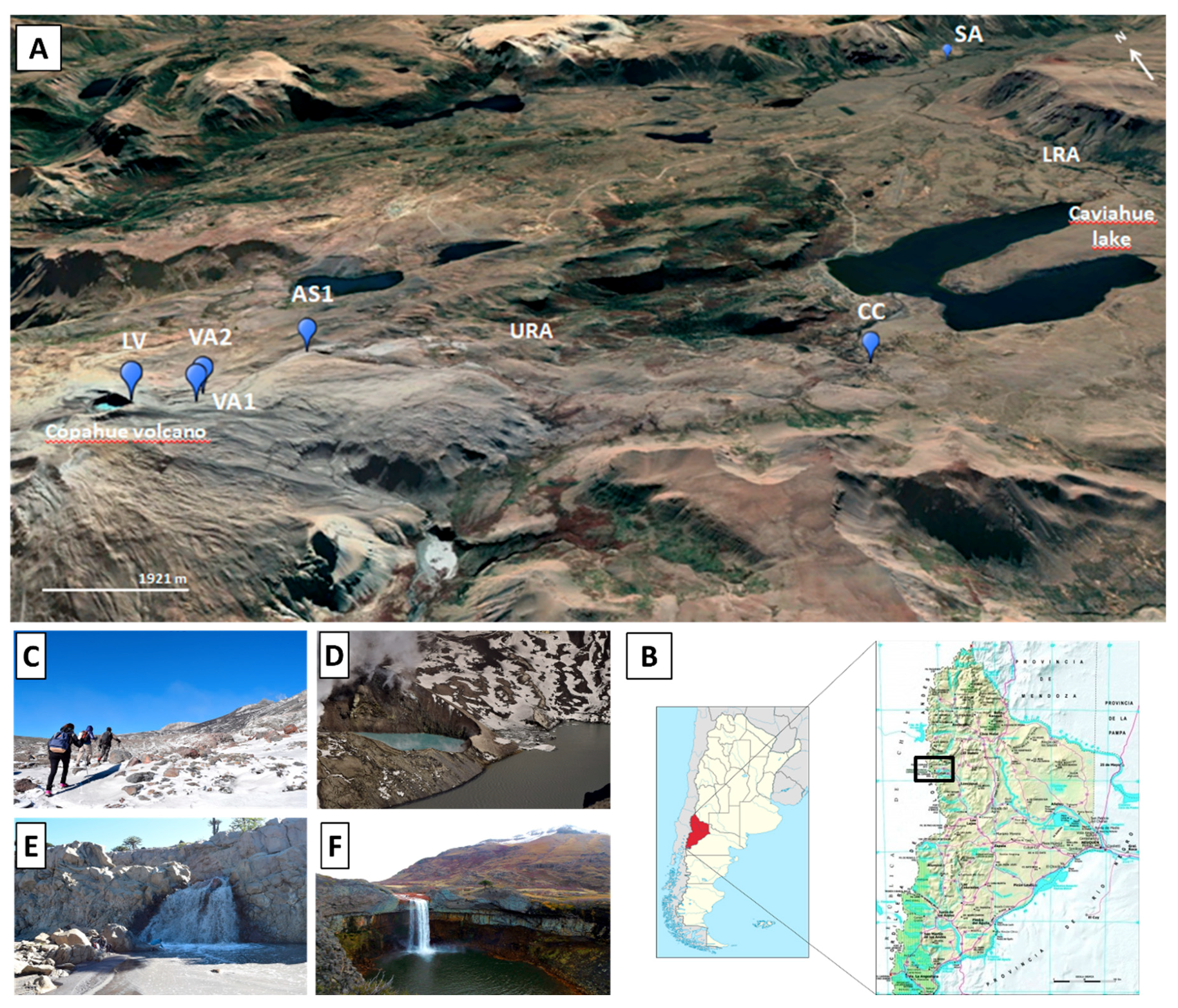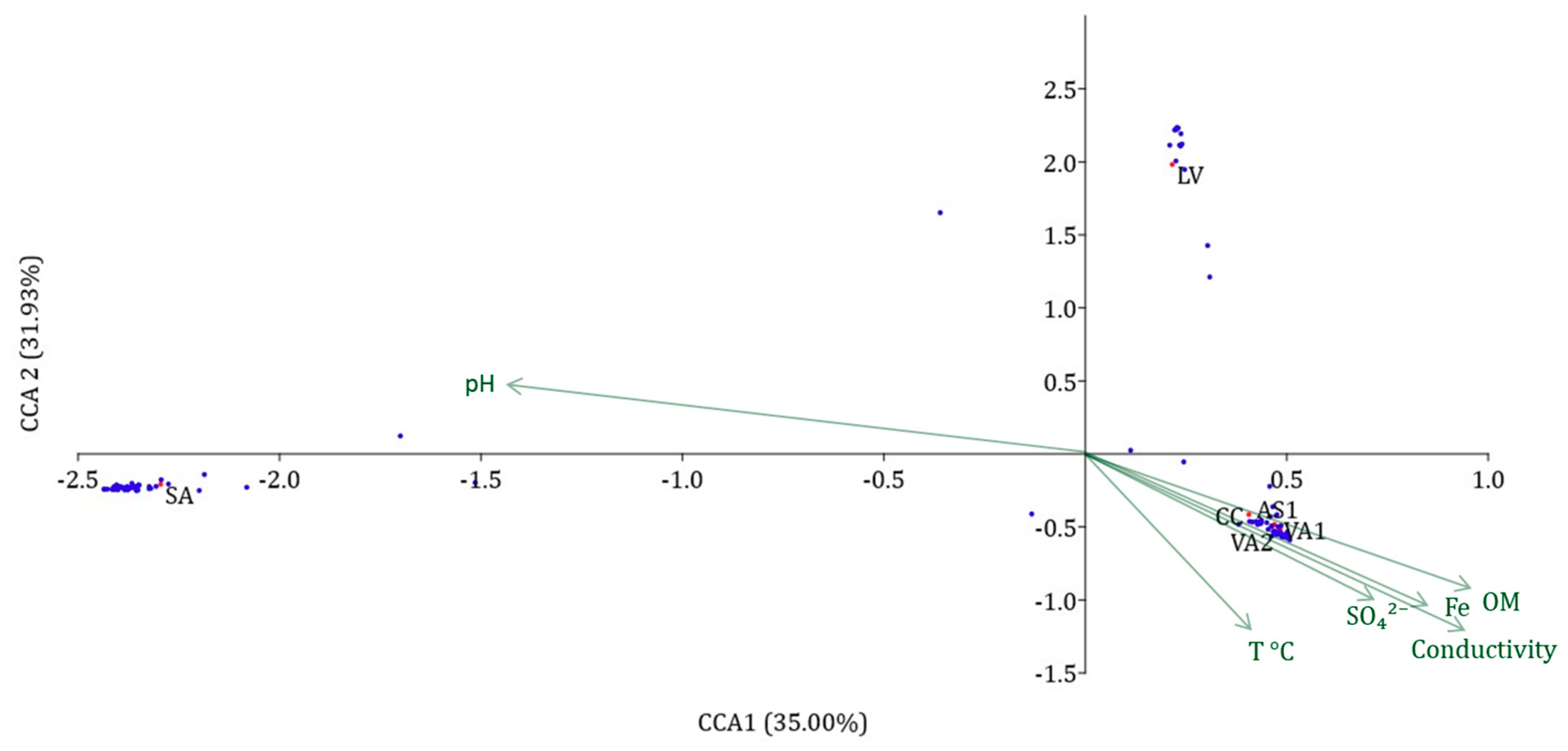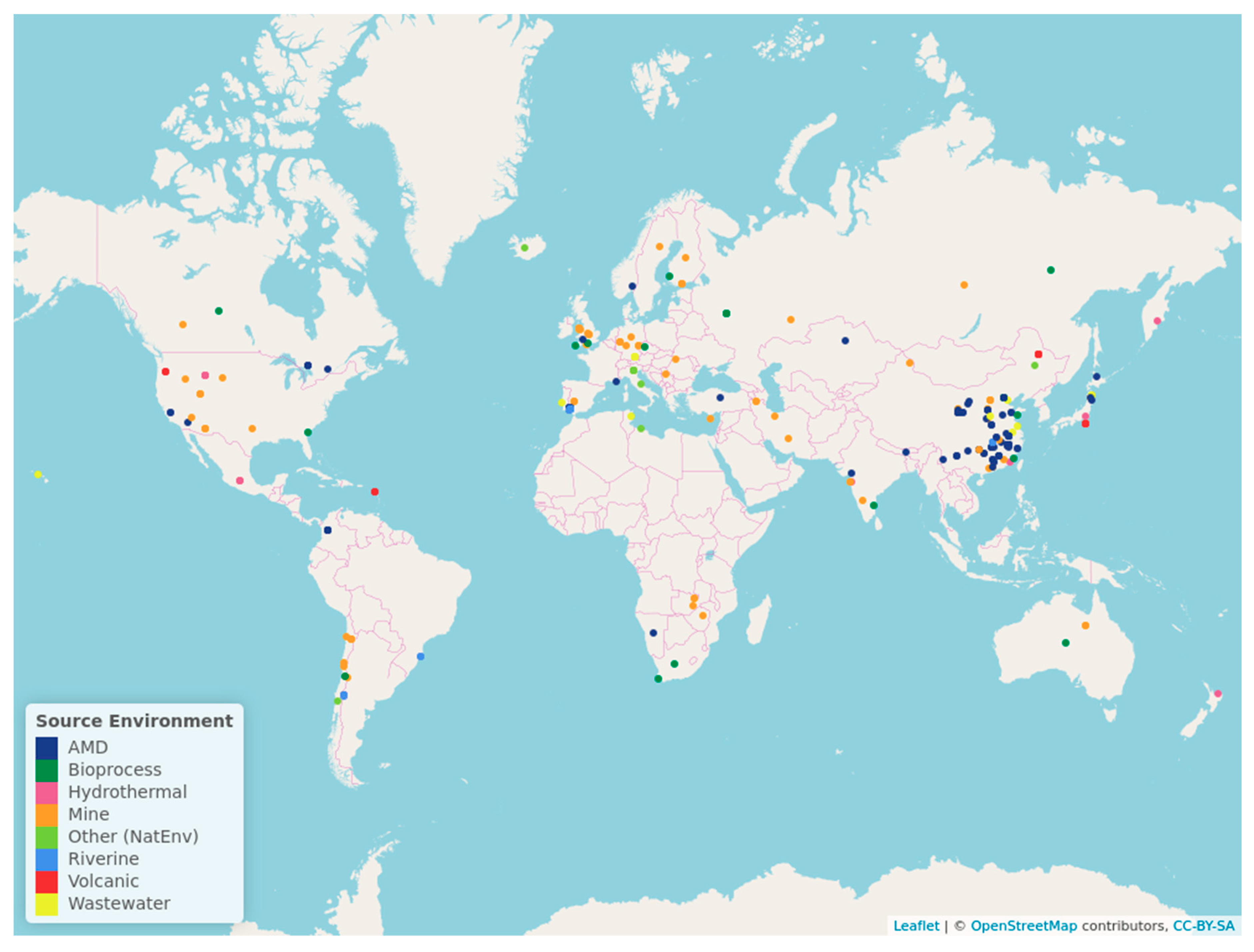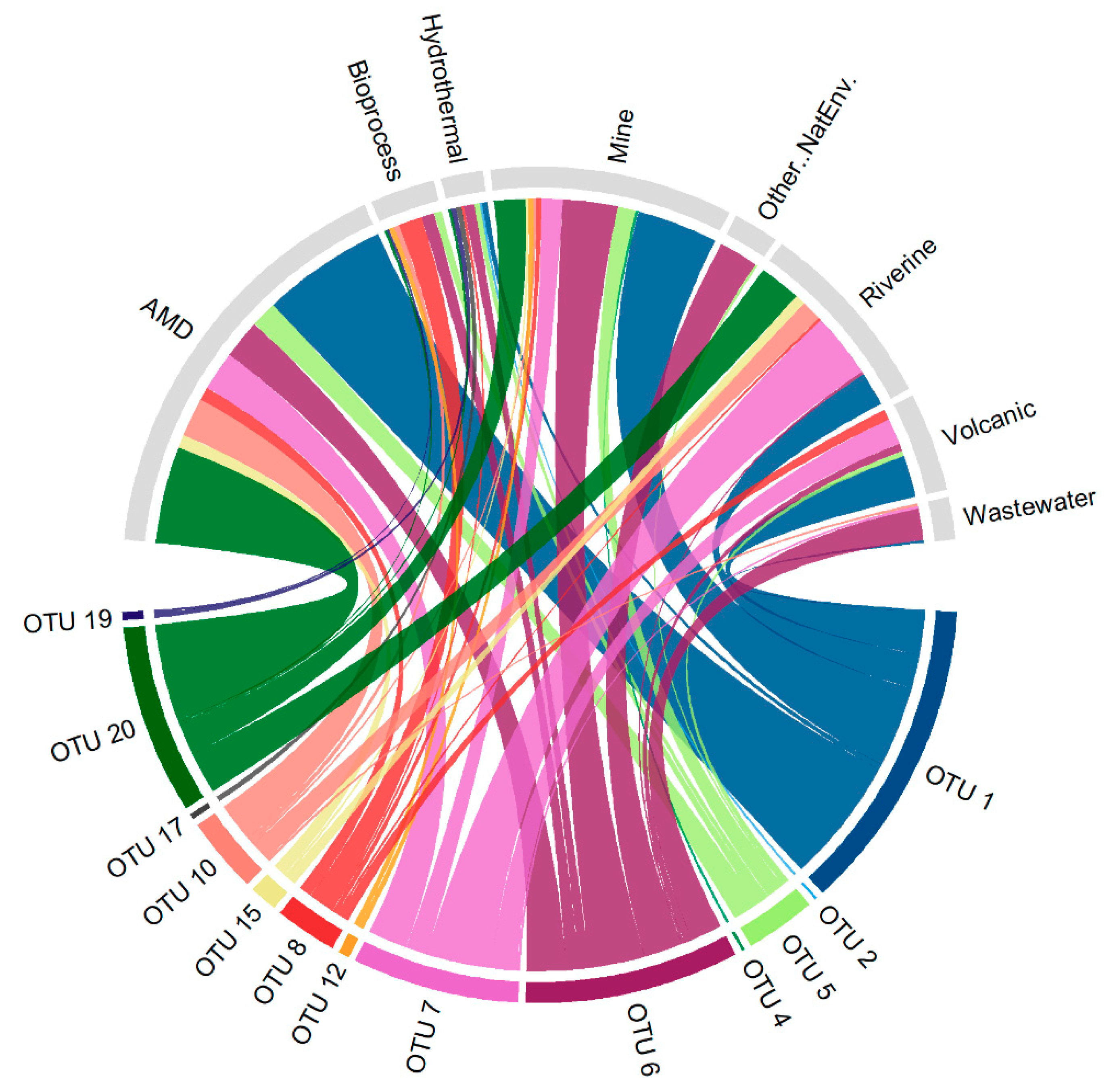A Deeper Look into the Biodiversity of the Extremely Acidic Copahue volcano-Río Agrio System in Neuquén, Argentina
Abstract
1. Introduction
2. Materials and Methods
2.1. Site Description, Sampling, and Phisicochemical Determinations
2.2. DNA Extraction and Sequence Processing
2.3. Statistical Analyses
2.4. OTUs Global Ocurrence
3. Results
3.1. Physicochemical Description of Rio Agrio
3.2. Sequencing and Diversity Analysis
3.2.1. Biodiversity Indexes
3.2.2. Taxonomic Composition of the Prokaryotic Diversity
3.2.3. Bacterial Diversity
3.2.4. Archaeal Diversity
3.3. Statistical Analysis of the Physicochemical Parameters and the Prokaryotic Biodiversity of the Copahue Volcano-Río Agrio System
4. Discussion
4.1. Influence of Geochemistry of the Río Agrio in Its Prokaryotic Biodiversity
4.2. Characteristics of the Prokaryotic Community of the Copahue Volcano-Río Agrio System
4.3. Global Occurrence of the OTUs
5. Conclusions
Supplementary Materials
Author Contributions
Funding
Acknowledgments
Conflicts of Interest
References
- Amils, R.; González-Toril, E.; Fernández Remolar, D.; Gómez, F.; Aguilera, A.; Rodríguez, N.; Malki, M.; García-Moyano, A.; Fairén, A.; de la Fuente, V.; et al. Extreme environments as Mars terrestrial analogs: The Rio Tinto case. Planet. Space Sci. 2007, 55, 370–381. [Google Scholar] [CrossRef]
- González-Toril, E.; Llobet-Brossa, E.; Casamayor, E.O.; Amann, R.; Amils, R. Microbial ecology of an extreme acidic environment, the Tinto River. Appl. Environ. Microbiol. 2003, 69, 4853–4865. [Google Scholar] [CrossRef] [PubMed]
- Garcia-Moyano, A.; Gonzalez-Toril, E.; Aguilera, A.; Amils, R. Comparative microbial ecology study of the sediments and the water column of the Rio Tinto, an extreme acidic environment. FEMS Microbiol. Ecol. 2012, 81, 303–314. [Google Scholar] [CrossRef] [PubMed]
- Sánchez-Andrea, I.; Rodríguez, N.; Amils, R.; Sanz, J.L. Microbial diversity in anaerobic sediments at Rio Tinto, a naturally acidic environment with a high heavy metal content. Appl. Environ. Microbiol. 2011, 77, 6085–6093. [Google Scholar] [CrossRef] [PubMed]
- Bomberg, M.; Mäkinen, J.; Salo, M.; Kinnunen, P. High Diversity in Iron Cycling Microbial Communities in Acidic, Iron-Rich Water of the Pyhäsalmi Mine, Finland. Geofluids 2019. [Google Scholar] [CrossRef]
- Aguinaga, O.E.; Wakelin, J.F.; White, K.N.; Dean, A.P.; Pittman, J.K. The association of microbial activity with Fe, S and trace element distribution in sediment cores within a natural wetland polluted by acid mine drainage. Chemosphere 2019, 231, 432–441. [Google Scholar] [CrossRef]
- Gao, P.; Sun, X.; Xiao, E.; Xu, Z.; Li, B.; Sun, W. Characterization of iron-metabolizing communities in soils contaminated by acid mine drainage from an abandoned coal mine in Southwest China. Environ. Sci. Pollut. Res. 2019, 26, 9585–9598. [Google Scholar] [CrossRef]
- Zhang, X.; Tang, S.; Wang, M.; Sun, W.; Xie, Y.; Peng, H.; Zhong, A.; Liu, H.; Zhang, X.; Yu, H.; et al. Acid mine drainage affects the diversity and metal resistance gene profile of sediment bacterial community along a river. Chemosphere 2019, 217, 790–799. [Google Scholar] [CrossRef]
- Leitholf, A.M.; Fretz, C.E.; Mahanke, R.; Santangelo, Z.; Senko, J.M. An integratemicrobiological and electrochemical approach to determine distributions of Fe metabolism in acid mine drainage-induced “iron mound” sediments. PLoS ONE 2019, 14. [Google Scholar] [CrossRef]
- Urbieta, M.S.; González-Toril, E.; Aguilera, A.; Giaveno, M.A.; Donati, E. First prokaryotic biodiversity assessment using molecular techniques of an acidic river in Neuquén, Argentina. Microb. Ecol. 2012, 64, 91–104. [Google Scholar] [CrossRef]
- Jones, D.S.; Schaperdoth, I.; Macalady, J.L. Biogeography of sulfur-oxidizing Acidithiobacillus populations in extremely acidic cave biofilms. ISME J. 2016, 10, 2879–2882. [Google Scholar] [CrossRef] [PubMed]
- Fontaneto, D.; Hortal, J. Microbial biogeography: Is everything small everywhere. In Microbial Ecological Theory: Current Perspectives; Ogilvie, L.A., Hirsch, P.R., Eds.; Caister Academic Press: Norfolk, UK, 2012; pp. 87–98. [Google Scholar]
- Holanda, R.; Hedrich, S.; Nancucheo, I.; Oliveira, G.; Grail, B.M.; Johnson, D.B. Isolation and characterisation of mineral-oxidising ‘Acidibacillus’ spp. from mine sites and geothermal environments in different global locations. Res. Microbiol. 2016, 167, 613–623. [Google Scholar] [CrossRef] [PubMed]
- Menzel, P.; Gudbergsdóttir, S.R.; Rike, A.G.; Lin, L.; Zhang, Q.; Contursi, P.; Moracci, M.; Kristjansson, J.K.; Bolduc, B.; Gavrilov, S.; et al. Comparative metagenomics of eight geographically remote terrestrial hot springs. Microb. Ecol. 2015, 70, 411–424. [Google Scholar] [CrossRef] [PubMed]
- Urbieta, M.S.; Willis-Porati, G.; Segretín, A.; González-Toril, E.; Giaveno, M.; Donati, E. Copahue geothermal system: A volcanic environment with rich extreme prokaryotic biodiversity. Microorganisms 2015, 3, 344–363. [Google Scholar] [CrossRef] [PubMed]
- Varekamp, J.C.; Ouimette, A.; Herman, S.; Flynn, K.S.; Bermúdez, A.H.; Delpino, D.H. Naturally acid waters from Copahue volcano, Argentina. Appl. Geochem. 2009, 24, 208–220. [Google Scholar] [CrossRef]
- Herrera, A.; Cockell, C.S. Exploring microbial diversity in volcanic environments: A review of methods in DNA extraction. J. Microb. Methods 2007, 70, 1–12. [Google Scholar] [CrossRef]
- Ma, Y.J.; Tie, Z.Z.; Zhou, M.; Wang, N.; Cao, X.J.; Xie, Y. Accurate determination of low-level chemical oxygen demand using a multistep chemical oxidation digestion process for treating drinking water samples. Anal. Methods 2016, 8, 3839–3846. [Google Scholar] [CrossRef]
- Schloss, P.D.; Westcott, S.L.; Ryabin, T.; Hall, J.R.; Hartmann, M.; Hollister, E.B.; Sahl, J.W. Introducing mothur: Open-source, platform-independent, community-supported software for describing and comparing microbial communities. Appl. Environ. Microbiol. 2009, 75, 7537–7541. [Google Scholar] [CrossRef]
- Kozich, J.J.; Westcott, S.L.; Baxter, N.T.; Highlander, S.K.; Schloss, P.D. Development of a dual-index sequencing strategy and curation pipeline for analyzing amplicon sequence data on the MiSeq Illumina sequencing platform. Appl. Environ. Microbiol. 2013, 79, 5112–5120. [Google Scholar] [CrossRef]
- Quast, C.; Pruesse, E.; Yilmaz, P.; Gerken, J.; Schweer, T.; Yarza, P. The SILVA ribosomal RNA gene database project: Improved data processing and web-based tools. Nucleic Acids Res. 2013, 41, 590–596. [Google Scholar] [CrossRef]
- R Core Team. R: A Language and Environment for Statistical Computing; R Foundation for Statistical Computing: Vienna, Austria, 2017; Available online: https://www.R-project.org/ (accessed on 22 July 2019).
- Kindt, R.; Coe, R. Tree Diversity Analysis: A Manual and Software for Common Statistical Methods for Ecological and Biodiversity Studies; World Agroforestry Centre (ICRAF): Nairobi, Kenya, 2005; ISBN 92-9059-179-X. Available online: http://www.worldagroforestry.org/output/tree-diversity-analysis (accessed on 23 July 2019).
- Hammer, Ø.; Harper, D.A.T.; Ryan, P.D. PAST: Paleontological statistics software package for education and data analysis. Palaeontol. Electron. 2001, 4, 9. Available online: http://palaeoelectronica.org/2001_1/past/issue1_01.html (accessed on 30 July 2019).
- Cheng, J.; Karambelkar, B.; Xie, Y. Leaflet: Create Interactive Web Maps with the JavaScript ‘Leaflet’ Library, R package version 2.0.2; 2018; Available online: https://CRAN.R-project.org/package=leaflet (accessed on 15 August 2019).
- Gu, Z.; Gu, L.; Eils, R.; Schlesner, M.; Brors, B. Circlize implements and enhances circular visualization in R. Bioinformatics 2014, 30, 2811–2812. [Google Scholar] [CrossRef] [PubMed]
- Urbieta, M.S. Diversidad Microbiana en Ambientes Volcánicos. Ph.D. Thesis, Universidad Nacional de La Plata, Buenos Aires, Argentina, November 2013. [Google Scholar] [CrossRef]
- Doménech, X. El Medio Hídrico Terrestre. QUÍMICA de la Hidrósfera, 3rd ed.; Miraguano: Madrid, Spain, 2000; pp. 17–35. [Google Scholar]
- Legendre, P.; Legendre, L. Numerical Ecology, 2nd English ed.; Elsevier: Amsterdam, The Netherlands, 1998; Volume 24, p. 853. [Google Scholar]
- Gammons, C.H.; Wood, S.A.; Pedrozo, F.; Varekamp, J.C.; Nelson, B.J.; Shope, C.L.; Baffico, G. Hydrogeochemistry and rare earth element behavior in a volcanically acidified watershed in Patagonia, Argentina. Chem. Geol. 2005, 222, 249–267. [Google Scholar] [CrossRef]
- Fernández-Remolar, D.C.; Rodriguez, N.; Gómez, F.; Amils, R. Geological record of an acidic environment driven by iron hydrochemistry: The Tinto River system. J. Geophys. Res. Planets 2003, 108, E7. [Google Scholar] [CrossRef]
- Lavalle, L.; Chiacchiarini, P.; Pogliani, C.; Donati, E. Isolation and characterization of acidophilic bacteria from Patagonia, Argentina. Process Biochem. 2005, 40, 1095–1099. [Google Scholar] [CrossRef]
- Chiacchiarini, P.; Lavalle, L.; Giaveno, A.; Donati, E. First assessment of acidophilic microorganisms from geothermal Copahue–Caviahue system. Hydrometallurgy 2010, 104, 334–341. [Google Scholar] [CrossRef]
- Watanabe, T.; Kojima, H.; Fukui, M. Sulfuriferula thiophila sp nov., a chemolithoautotrophic sulfur-oxidizing bacterium, and correction of the name Sulfuriferula plumbophilus Watanabe, Kojima and Fukui 2015 to Sulfuriferula plumbiphila corrig. Int. J. Syst. Evol. Microbiol. 2016, 66, 2041–2045. [Google Scholar] [CrossRef]
- Johnson, D.B.; Bacelar-Nicolau, P.; Okibe, N.; Thomas, A.; Hallberg, K.B. Ferrimicrobium acidiphilum gen. nov., sp. nov. and Ferrithrix thermotolerans gen. nov., sp. nov.: Heterotrophic, iron-oxidizing, extremely acidophilic actinobacteria. Int. J. Syst. Evol. Microbiol. 2009, 59, 1082–1089. [Google Scholar] [CrossRef]
- Kadnikov, V.V.; Gruzdev, E.V.; Ivasenko, D.A.; Beletsky, A.V.; Mardanov, A.V.; Danilova, E.V.; Karnachuk, O.V.; Ravin, N.V. Selection of a Microbial Community in the Course of Formation of Acid Mine Drainage. Microbiology 2019, 88, 292–299. [Google Scholar] [CrossRef]
- Sanyika, T.W.; Stafford, W.; Cowan, D.A. The soil and plant determinants of community structures of the dominant actinobacteria in Marion Island terrestrial habitats, Sub-Antarctica. Polar Biol. 2012, 35, 1129–1141. [Google Scholar] [CrossRef]
- Marnocha, C.L.; Dixon, J.C. Bacterially facilitated rock-coating formation as a component of the geochemical budget in cold climates: An example from Kärkevagge, Swedish Lapland. Geomorphology 2014, 218, 45–51. [Google Scholar] [CrossRef]
- Yang, Y.; Yang, L.I.; Sun, Q.Y. Archaeal and bacterial communities in acid mine drainage from metal-rich abandoned tailing ponds, Tongling, China. Trans. Nonf. Met. Soc. China 2014, 24, 3332–3342. [Google Scholar] [CrossRef]
- Giaveno, M.A.; Urbieta, M.S.; Ulloa, J.R.; González-Toril, E.; Donati, E.R. Physiologic versatility and growth flexibility as the main characteristics of a novel thermoacidophilic Acidianus strain isolated from Copahue geothermal area in Argentina. Microb. Ecol. 2013, 65, 336–346. [Google Scholar] [CrossRef] [PubMed]
- Harrison, A.P., Jr. Acidiphilium cryptum gen. nov., sp. nov., heterotrophic bacterium from acidic mineral environments. Int. J. Syst. Evol. Microbiol. 1981, 31, 327–332. [Google Scholar] [CrossRef]
- Ziegler, S.; Waidner, B.; Itoh, T.; Schumann, P.; Spring, S.; Gescher, J. Metallibacterium scheffleri gen. nov., sp. nov., an alkalinizing gammaproteobacterium isolated from an acidic biofilm. Int. J. Syst. Evol. Microbiol. 2013, 63, 1499–1504. [Google Scholar] [CrossRef]
- Lima, M.A.; Urbieta, M.S.; Donati, E. Characterization of diverse arsenic-tolerant enrichment cultures from sediments of Copahue geothermal system. J. Basic Microbiol. 2019, 59, 680–691. [Google Scholar] [CrossRef]
- Urbieta, M.S.; González-Toril, E.; Bazán, Á.A.; Giaveno, M.A.; Donati, E. Comparison of the microbial communities of hot springs waters and the microbial biofilms in the acidic geothermal area of Copahue (Neuquén, Argentina). Extremophiles 2015, 19, 437–450. [Google Scholar] [CrossRef]
- Korzhenkov, A.A.; Toshchakov, S.V.; Bargiela, R.; Gibbard, H.; Ferrer, M.; Teplyuk, A.V.; Golyshina, O.V. Archaea dominate the microbial community in an ecosystem with low-to-moderate temperature and extreme acidity. Microbiome 2019, 7, 11–25. [Google Scholar] [CrossRef]





| Site | LV | VA1 | VA2 | AS1 | CC | SA |
|---|---|---|---|---|---|---|
| Coordinates | S 37° 51′ 21′’ | S 37° 51′ 23′’ | S 37° 51′ 18′’ | S 37° 50′ 59′’ | S 37° 53′ 08′’ | S 37° 48′35′’ |
| W 71° 09′ 29′’ | W 71° 09′ 04′’ | W 71° 08′ 59′’ | W 71° 08′ 00′’ | W 71° 04′ 02′’ | W 70° 55′33′’ | |
| pH | 2.79 | 1.92 | 2.00 | 2.06 | 2.50 | 3.89 |
| T (°C) | 4.00 | 41.00 | 28.80 | 12.00 | 15.90 | 12.60 |
| Conductivity (µs/cm) | 1402.00 | 27,100.00 | 20,600.00 | 16,990.00 | 7770.00 | 350.00 |
| Eh (mV) | ND | 365.00 | 398.00 | 382.00 | 405.00 | 310.00 |
| Cl− (mg/L) | 0.70 | 5562.10 | 3771.73 | 3103.32 | 978.74 | 30.79 |
| NO₃− (mg/L) | 11.20 | 8.82 | 49.28 | 49.45 | 23.34 | 0.36 |
| SO₄²¯ (mg/L) | 78.49 | 2841.01 | 2616.18 | 2479.92 | 98.79 | 20.64 |
| Organic matter (mg/L) * | 4.23 | 8.84 | 12.78 | 23.53 | 13.22 | 2.91 |
| Ca (mg/L) | 24.38 | 565.82 | 547.06 | 418.90 | 232.58 | 13.44 |
| Na (mg/L) | 22.50 | 1050.00 | 620.00 | 480.00 | 257.00 | 14.20 |
| K (mg/L) | 2.70 | 60.00 | 41.00 | 58.00 | 25.00 | 3.60 |
| Fe (mg/L) | 55.48 | 998.41 | 780.08 | 693.06 | 241.61 | 12.92 |
| Mn (mg/L) | 1.08 | 45.71 | 29.55 | 24.83 | 11.79 | 0.48 |
| LV | VA1 | VA2 | AS1 | CC | SA | |
|---|---|---|---|---|---|---|
| Observed OTUs | 290 | 311 | 280 | 331 | 504 | 681 |
| Shannon-Wiener | 2.276 | 2.445 | 2.483 | 2.505 | 2.925 | 4.326 |
| Inverted Simpson | 3.832 | 6.350 | 5.683 | 6.162 | 5.787 | 28.498 |
© 2019 by the authors. Licensee MDPI, Basel, Switzerland. This article is an open access article distributed under the terms and conditions of the Creative Commons Attribution (CC BY) license (http://creativecommons.org/licenses/by/4.0/).
Share and Cite
Lopez Bedogni, G.; Massello, F.L.; Giaveno, A.; Donati, E.R.; Urbieta, M.S. A Deeper Look into the Biodiversity of the Extremely Acidic Copahue volcano-Río Agrio System in Neuquén, Argentina. Microorganisms 2020, 8, 58. https://doi.org/10.3390/microorganisms8010058
Lopez Bedogni G, Massello FL, Giaveno A, Donati ER, Urbieta MS. A Deeper Look into the Biodiversity of the Extremely Acidic Copahue volcano-Río Agrio System in Neuquén, Argentina. Microorganisms. 2020; 8(1):58. https://doi.org/10.3390/microorganisms8010058
Chicago/Turabian StyleLopez Bedogni, Germán, Francisco L. Massello, Alejandra Giaveno, Edgardo Rubén Donati, and María Sofía Urbieta. 2020. "A Deeper Look into the Biodiversity of the Extremely Acidic Copahue volcano-Río Agrio System in Neuquén, Argentina" Microorganisms 8, no. 1: 58. https://doi.org/10.3390/microorganisms8010058
APA StyleLopez Bedogni, G., Massello, F. L., Giaveno, A., Donati, E. R., & Urbieta, M. S. (2020). A Deeper Look into the Biodiversity of the Extremely Acidic Copahue volcano-Río Agrio System in Neuquén, Argentina. Microorganisms, 8(1), 58. https://doi.org/10.3390/microorganisms8010058







